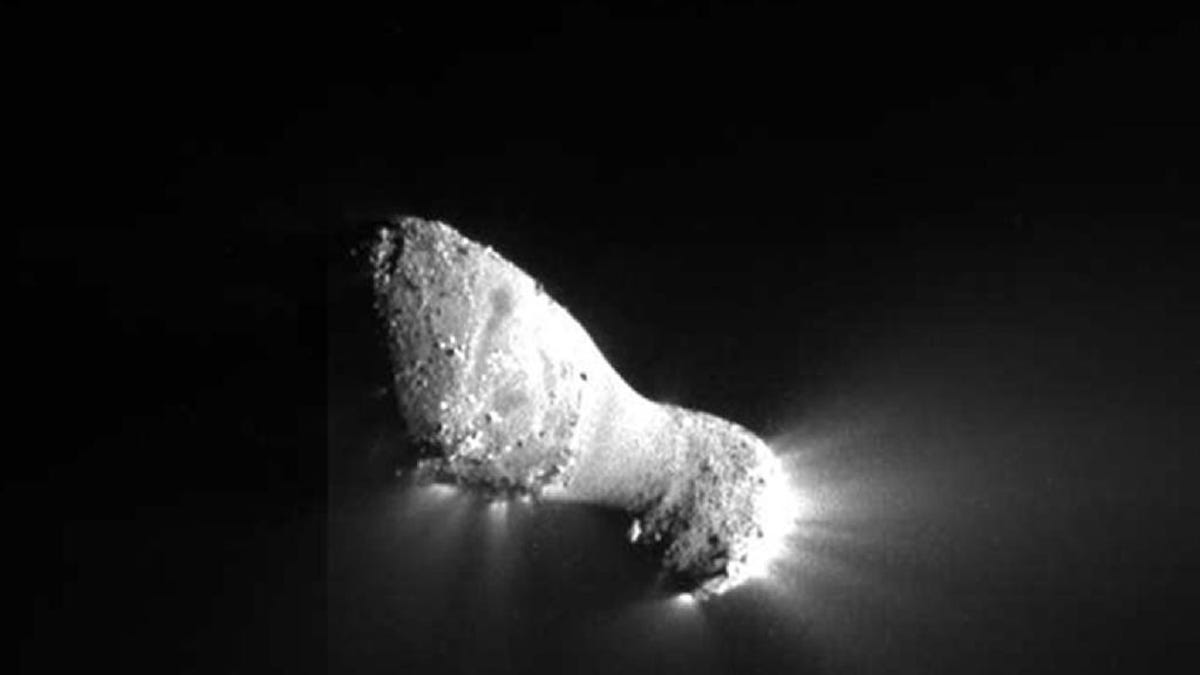NASA images capture icy nucleus of distant comet
In a precision, high-speed flyby, a recycled NASA spacecraft takes spectacular images of a peanut-shaped comet's frozen nucleus and multiple jets of icy debris.

A recycled NASA spacecraft passed within 435 miles of Comet Hartley 2 today and beamed back spectacular pictures revealing a strange, peanut-shaped nucleus spewing multiple jets of icy debris.
The Deep Impact spacecraft, the centerpiece of a repurposed mission known by the acronym EPOXI, flew past Hartley 2 at more than 7 miles per second, or 27,000 mph, making its closest approach at 7 a.m. PT.
A few moments later, the spacecraft reoriented itself and aimed its high-gain antenna back toward Earth to begin relaying stored pictures and telemetry. In 2005, the spacecraft flew past comet Tempel 1, blasting out a crater with a small sub-satellite.
The first images sent back today were shot with a medium-resolution camera, starting 18 hours before close approach. As subsequent images came in from deep space, the comet grew in size and clarity on computer monitors in the control room at NASA's Jet Propulsion Laboratory in Pasadena, Calif.
As the first close-up images came in, engineers and scientists in the control room burst into applause.
The images showed a peanut-shaped nucleus with a jet of debris extending away from one end and other, smaller jets at different locations around the body. Ridges and pits could be seen in the black-and-white images, prompting repeated outbursts of applause and cheers.
Scientists already knew Hartley 2 had a dual-lobe shape based on ground-based radar images obtained earlier. But the clarity of the pictures from Deep Impact's medium-resolution camera showed a remarkable level of detail. Pictures from the spacecraft's high-resolution telescope are expected later.
"It dawned on me as we were waiting for that first picture, we had no idea what we were going to see other than it was going to be a weird-shaped object," Ed Weiler, director of space science at NASA headquarters, told the EPOXI team. "That was the exploration part. Now the fun really starts. Now we've got to explain what the hell we're looking at. That's the science!"
Principal Investigator Michael A'Hearn at the University of Maryland said last month the primary goal of the encounter was to learn more about the evolution of the so-called "dirty snowballs," believed to have formed during the birth of the solar system 4.5 billion years ago, what causes differences in appearance and behavior and how those differences might reflect the initial composition of the solar nebula.
"The nucleus of Comet Hartley 2 is about three-quarters of a mile across compared to the four miles across for comets Tempel 1, our prime mission target, Wild 2, and Borelli," A'Hearn said. "So it's a much smaller nucleus. Despite that, it puts out more gas every minute than does Tempel 1.
"So this says it's a really active nucleus for its size. And this is what sets it apart and what will enable us to try to separate the features on the nucleus that are driven by the outgassing process and the evolution of the comet from the aspects of the nucleus that are primordial and can tell us how the planets formed four and a half billion years ago."
Before today's encounter, only four comets had been closely imaged by passing spacecraft: Halley, Wild 2, Borelli, and Tempel 1.
"You'll notice they are very different from one another, both the overall shape and the kinds of features on the surface," said Tim Larson, EPOXI project manager at NASA's Jet Propulsion Laboratory. "Three of them are about the same size, about four miles across, Halley is about twice as big.
"What we want to understand is why these differences occur when we don't see obvious differences in the processes that should shape what we see. What we wanted to do was go to a small nucleus and Comet Hartley 2 had been identified as early as the Deep Impact prime mission as a potential target."
NASA managers initially selected a different target, but that comet apparently broke apart and disappeared. The team then shifted its focus to Hartley 2, discovered by Australian astronomer Malcolm Hartley in March 1986.
"It's a very special time for me, I never imagined 24 years ago that I'd be witnessing something like this," Hartley said during a media teleconference last month. "When I saw the comet, it was millions and millions of kilometers away, and it's only going to be about 700 kilometers away when I next see it. So I'm extremely excited and feel very privileged to be here."
Hartley was present in the control room at JPL as Deep Impact flew past at some 435 miles. The approach distance was set to maximize the science return and to ensure the spacecraft's protection from jets of carbon dioxide gas and debris.
"The closer we get to the comet, the better our image resolution, so we want to get as close as we can," said Larson. "But we're also limited by the turn rate of the spacecraft. As the comet zooms by us, we have to be able to turn fast enough to track it all the way by.
"And so at 700 kilometers, it stays well within our capability to do that. If we get too much closer than 700 kilometers, we also start getting into a denser portion of the coma that poses more threats of damage to the spacecraft due to the particles that are there."

